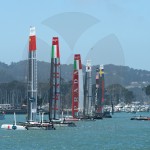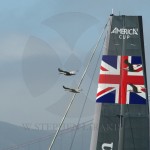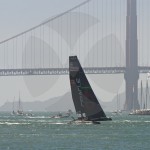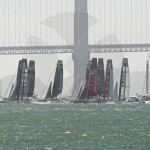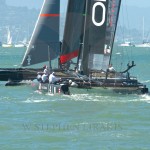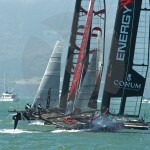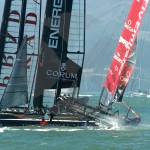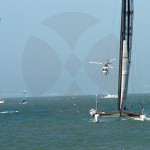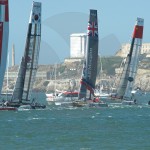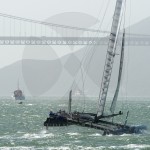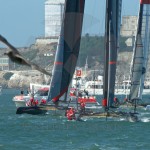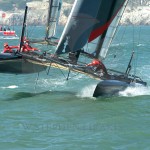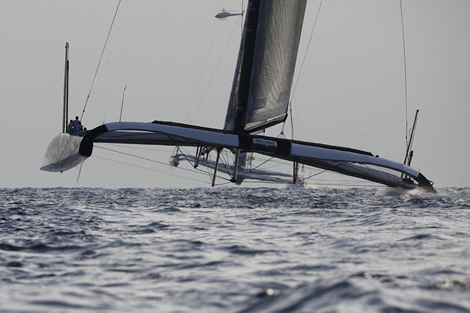Tag: russell coutts
AC ACTION IN SAN DIEGO
HERE is link to the America’s Cup in San Diego. The America’s Cup governing body is living up to their restriction of any and all media surrounding the series.
FRIDAY THE 13TH FOR THE AMERICA’S CUP
A symptom of too much change? Or simply of time zones? The Challenger of Record “Mascalzone Latino” has withdrawn from the America’ Cup. The position of the challenger of record is an important one. It is their job to co ordinate with the defender, in this case “Oracle” on almost all aspects of how the regatta would be conducted: and to represent the challengers as a group in this process. Vincent Onorato’s statement is below.
We could speculate about the “real” reasons for the withdrawal of the “Rascals”. Anyone who has been following the news of the America’s Cup has seen that Larry Ellison has gotten his way almost without interruption so far. Given his reputation it would not be hard to imagine that there has been little co operation. I would still contend that Europe would be a better venue for the America’s Cup; particularly in it’s present form.
The total number of teams is presently fourteen.
Dear Friends and Supporters,
with deep sorrow I have to announce my decision to withdraw my team from the 34th America’s Cup.
Since the very beginning of our role as Challenger of Record, I have been working on this project focused to bring the Cup in our Country.
Larry deeply loves Italy and he was excited about this idea. The Cup in Italy would have been the greatest worldwide promotion for our beautiful coasts. There have been some very high level and important meetings that made us believing in this dream, but the things went in a different way.
“As Challenger of Record, we have worked with humility next to Oracle and I am satisfied of the result we have reached: a new Cup, spectacular, with new boats, the catamarans, that will launch on the international scene a new generation of sailors.
With Russell we have discussed for long time on the most difficult challenge that the next Cup must face: an international situation with big economic crisis and therefore huge difficulties to find sponsor. This is the only, true, real enemy of the next Cup. We have then thought of the idea to create the class AC45, a concrete way to make lot of teams get involved in the event reducing costs, at least in the delicate period of the start-up.
On our side, I must thank the two Italian sponsors that believed and confirmed us their trust. We are not able, however, to reach a budget that allows us to be a competitive team.
In our sport, men in blazer have overcome by now those in oilskins, I’m a man in oilskin and when I go in the sea, I want to win. I’m not interested in a hopeless challenge, I would lie to the sponsors, to our fans and last but not least also to myself.
I would like to thank our friends from Club Nautico di Roma. I am sure that we will have new exciting adventures together.
The sailing adventure of Mascalzone Latino doesn’t end anyway with the Cup, but it continues with the sailing school in Naples, free of charge, for those children coming from the most difficult areas of this town. A daily challenge, and, who knows, maybe someday we will see a new America’s Cup champion coming out from one of them.
Fair wind to all of you.”
“FROM THE FLINTSTONE GENERATION TO THE FACEBOOK GENERATION”
Russell Coutts got everyone’s attention with this remark. My generation is mildly insulted and the next wholly amused; since they probably think it is time we moved over and made room for them.
He is not without his critics; but they may be a bit premature as no one can yet know what the outcome of the bold changes Russell is bringing to sailing and the America’s Cup. I admit(perhaps showing the flintstone side of me) that I am unsure of what to make of the “new” face of the America’s Cup. But the Cup has always been about change.
At the recent 12 meter era reunion much was made of the remark. Honestly, we were probably the group to which he was referring. I will add the the 12 meters are not only a suitable, slow boat, but so very elegant to watch.
RUSSELL COUTTS PART 2
Once again this interview is thanks to James Boyd of the Daily Sail. Anyone who reads scuttlebutt, sailing anarchy or any of the other sailing site must have noticed that there is a great deal of conversation about the direction of sailing and the direction of the America’s Cup. People still look for the Cup to exhibit leadership. There is a lot of criticism from all sides right now. I am not sure people know what it is that they want themselves.
We started this article by stating that Coutts has effectively started out from a blank piece of paper with his vision for the 34th America’s Cup and while teams wrestle with the design of their AC72s, one of the hardest tasks for Iain Murray to establish is the best race format that on the one hand satisfies that reasonably vague concept sailors term ‘fair racing’ and maximising the spectacle and excitement of the competition, as if racing boats capable of 40+ knots weren’t enough.
“To make a difference it is going to have to be a lot more exciting than what it’s been,” states Coutts. “When experts look at the audience figures from AC32 and work out what they actually mean, they are much lower than what we need to achieve to make this viable. I think we have got to look at what we have to do to engage the non-sailing public. We have to get away from some of the complicated rules and terminology and processes that we have had in the past for years and years that I think have stymied the whole understanding for people watching it.” So we can expect more understandable methods for the race committee to communicate with competitors (ie no flags) and almost certainly a simplification of the match racing rules and terminology wherever possible.
As to the ‘fair racing’ issue that requires competition to be three miles out to sea, away from land effects, Coutts says: “To my way of thinking the people that are looking at that are really saying that ‘what we want are absolutely steady conditions so that the fastest boat will win.’ But wind shifts are part of the game and maybe that is a good thing to have it in a shifty venue that has maybe got some obstructions around the course so that we have other things to consider and it isn’t just about the fastest boat winning.”
So possibly for the first time the 34th America’s Cup may not be primarily a design competition.
With match racing, particularly with standard windward-leeward courses being perpetually reduced in length, then the start is perhaps overly important to the final outcome of a race. For this reason Coutts says it is likely that the first upwind leg will be a substantially shortened.
Nice multihulls
“It is amazing the number of people who draw conclusions about multihull racing, that ‘it is not tactical’, ‘it is easier and not as skilful as monohull sailing’. Most of those people have never sailed a modern multihull. I think that most of the monohull sailors who go racing in a good multihull fleet get surprised and say this racing is actually very tactical and very cool.” He cites the numerous monohull sailors who competed in the 33rd America’s Cup.
A frequent criticism for example is that multihulls tack poorly and therefore racing them is simply a case of picking a side and heading out to the layline to the next mark to minimise the number of manoeuvres. This is not as true as it once was.
“The wing will allow the boat to tack quite a lot better than a lot of people think of traditional multihulls with the traditional fine deep bows that were really draggy in a tack,” says Coutts. “Now I think they will not tack fantastically, but better than they have ever done and being the America’s Cup choice those systems will be refined with the daggerboards and so forth.”
As to the number of manoeuvres, tacking duels, etc Coutts says they are looking at putting boundaries on the course so that the laylines are simply taken out of play and this will force more manoeuvring. The typical diamond-shaped race course will perhaps become more a rectangle with pointy ends, although we imagine a reaching leg or two, when the multihulls will be able to show off their highest speeds, might also be included. Obviously teams are clamouring for a final decision to be made about this at the earliest opportunity as it will have a major impact on the design of their AC72s.
“A lot of people are judging the multihull now,” says Coutts. “I think we’ll end up judging it in three years time. A lot of people try to make comparisons with the last AC for example. Well I would say that if you went out and got two monohulls with the only restriction being a 90ft waterline and raced them around a 20 mile course you’d get a pretty uneven race and my money would be on it being a pretty boring race, not even as interesting as what we saw. So if you make a good multihull rule, which I believe they are doing, that produces relatively even boats, that rewards good sailing and you get the course configuration right, then the match racing will be good quality.”
In particular when racing faster boats, be they monohull or multihull, Coutts points out that there tends to be more passing opportunities than in slower boats, when typically it is much easier for the boat in front to defend their lead. “If we can get the course configurations right you will see more passing and it will be pretty compelling. If the boats are faster too and if we have a short course format – it will still be quite long because the boats will be high speed – but they might be manoeuvring every three minutes.
“Everyone talks about Fremantle being fantastic and it produced great images at the time, but go back and look at the races now and there is a lot of straight line sailing. I think to make the next jump we have to move quite a bit beyond that. It is not a little tweak here and there, if we want to attract more of the general public to our sport then we have to take some steps to change quite a few things.”
The America’s Cup brand
We have mentioned in previous articles that the change to an ultra-modern high performance catamaran and a more action-packed race format could change the flavour of the event, that in marketing terms it becomes more ‘Red Bull’ than ‘Louis Vuitton’.
Coutts disagrees: “I don’t see it rules out the luxury brands at all. In fact, quite the contrary. I think it depends a lot on what else is going on around the event and the way it is set up and the facilities on shore and the way it is organised on the water and so forth. I think it might appeal to a broader range of sponsors, but I still think the luxury brands will be there. This is still going to be perceived as the top end of technology and the top of sailing.”
In summary
Coutts is looking to revolutionise the America’s Cup, and create a sports event many times more appealing than it has ever been in the past. If it comes to pass, then that means more interest in not just the America’s Cup but sailing in general, ultimately leading to more participation and this can only be a good thing for all of us involved.
As he concludes: “Of course you have the tradition element of the sport who would love it to stay the same forever, but all I can say to that is that the world is changing. What appeals to my kids – it is a different world to when I grew up. They have access to different information and different things and we can’t keep a closed mind on this stuff. What may have been fun when I was 15 years old, 15 year olds of today view things differently.”
The acid test as ever is whether what is proposed is capable of making teenagers voluntarily put down their Xboxes and PlayStations.
RUSSELL COUTTS SPEAKS,
The following is an interview by James Boyd with Russell Coutts :
Russell Coutts’ vision for the 34th America’s Cup represents the most dramatic upheaval our sport has possibly ever seen as the BMW Oracle Racing boss attempts to drag yacht racing into the 21st century, virtually wiping the slate clean and replacing it with a dramatic sporting event to appeal to the masses. So any opportunity to glean some more insight into this is one we have to grab.
AC34 venue announcement imminent
While we were expecting an announcement about the venue for the 34th America’s Cup to come in December, according to Coutts this should now be this month (ie imminently). “Obviously these are complex negotiations, so you never quite know when it will be finalised, but we have a schedule for finalising that contract and it is progressing according to the schedule.”
Valencia has the facility but not the financial resource it had five years ago, so the toss-up seems to be between a venue near Rome and San Francisco; the latter, home of both Larry Ellison and the Golden Gate Yacht Club, felt to have the upper hand at present.
AC45
Tooling is well underway in Warksworth, New Zealand for the new generation of AC45s, with the first boat scheduled to be launched around this Christmas. This seems incredibly swift, even more so when you consider that the process is all the complex because the team, led by Tim Smyth and Mark Turner, are gearing up for a production run.
After its launch, the first AC45 will obviously undergo sea trials. “Hopefully we won’t have to change much, but there are always bugs to iron out with a new class,” says Coutts. “So it will be a case of checking that the systems are correct and also that the build weights come out on their targets, which I’m pretty sure they will.” This first boat will belong to ACRM and be used as the spare boat at the World Series regattas to commence in 2011.
“The AC45s are proving to be better and more valuable that what we all originally thought, particularly when you look at the possibilities for example of building awareness in the US or places like that which we need to do,” says Coutts.
Initially the AC45s will only be for America’s Cup teams however there has also been interest in acquiring them from outside of the Cup community and it doesn’t take a leap of imagination to see such boats competing on Lake Geneva for example. “They will be cool boats. The rig is not overly high, so they might be a bit underpowered for Lake Geneva,” says Coutts, who in the past has been a regular on the D35 circuit.
Despite the catamaran with solid wingsail concept being one of apparent frailty, the boat has been designed to be reasonably bulletproof confirms Coutts. “It is definitely designed like that. The rig height is relatively short, but they will power up with a big headsail in light winds. It is a reasonably simple wing, similar in concept to the wing we used on the tri. It will bring teams up to speed with the way you sail with wings and wing technology very quickly.”
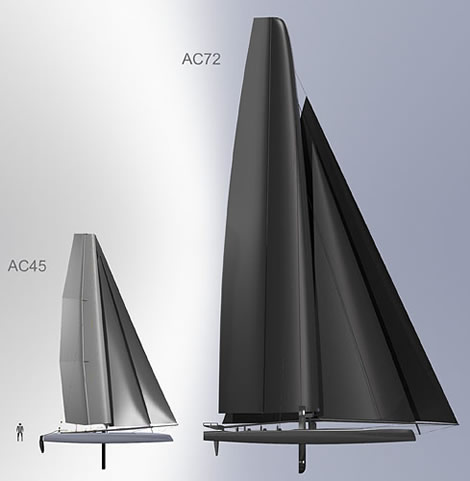
AC45 racing in 2011 – World Series
According to Coutts the first event to be staged in the AC45s for the America’s Cup teams will be “in the middle of 2011” and he is now expected there to be more than three events through the latter half of next year. However he adds that the choice of Cup venue is central to the location of these AC World Series events, so we can assume perhaps that if the choice of venue is San Francisco, then the World Series events in 2011 will be mostly in North America. We would hazard a guess at San Francisco, Newport, San Diego and New York.
Teams
Obviously crucial to the success of the 34th America’s Cup is the number of teams taking part and Coutts wishes to point out that while there has been much press about teams not wishing to compete – TeamOrigin being the most high profile withdrawal recently – there has been relatively little about teams coming in. The problem of course is that at present it is hard determine this as the period in which they can formally challenge does not open until 1 November and is then open until 31 March 2011, and there is still an opportunity after this when challengers will have to pay a late entry fee.
What we know so far is that as Challenger of Record, Vincenzo Onorato’s Mascalzone Latino is in there. Torbjorn Tornqvist’s Artemis seems to be firing on all cylinders with Paul Cayard in charge. Emirates Team New Zealand are taking the right steps with Dean Barker having sailed his first Extreme 40 regatta last week, but Grant Dalton yesterday told the New Zealand Herald that their participation is far from confirmed.
The Franco-German All4One team, led by Stephane Kandler and Jochen Schuemann, is also in the game and we understand that from the multihull world Cam Lewis is attempting to put together another US syndicate to compete in a ‘defender trial’ while former Olympic Tornado sailor and Extreme 40 co-creator Herbert Dercksen hopes to mount a campaign from the Netherlands.
“I think we’ll probably get eight,” is Coutts’ prediction. As to whether or not these will also be top league remains to be seen. “I think most of them will be. Most of them have got adequate funding to be good. There are plenty of good people around and this is a new format, so I think it will be all on. There are some new ones looking hard at it.”
And Ernesto Bertarelli – a multihull skipper of some 20 years experience and the one team principle best suited to the type of boats Coutts is proposing? “I hope so,” says Coutts.
Money, money, money
Coutts is also keen to refute some of the claims, made for example by TeamOrigin, concerning the price of a competitive campaign. “There have been some claims that it is going to cost 20% more than an 32nd AC campaign. I don’t know what budgets those people who made those claims were looking at, but I think they were looking at a different business plan to the one I was…”
He cites the numerous cost cutting measures introduced compared to campaigns for the 32nd America’s Cup – 11 rather than 17 crew, a 72ft yacht (albeit a catamaran) compared to a 82-85ft one, a strict limitation on two boat testing, etc.
One of the principle cost savings will come from the different team set-up. Instead of the Valencia-type scenario where campaigns have a permanent base and where the majority of their staff reside, with families relocated, etc, instead Coutts envisages more of a Formula 1-type scenario where the majority of the teams have a substantially smaller fixed base, or perhaps separate bases for marketing and design departments plus a travelling road show, featuring the sailors, shore crew, etc.
“I know that we are saying to our people ‘live wherever you want, but we need you at these regattas’,” Coutts says. “So that is a huge cost saving – one of the biggest probably. Some of the designers will need to be together and perhaps even some of the sailors, but as a general rule you aren’t going to need 120 people based in one place together for four years.”
Teams on the AC World Series are more likely to have bases similar to the impressive ones that do a lap of the planet with the Volvo Ocean Race. Coutts doesn’t believe that permanent structures, like those around the perimeter of the Darsena in Valencia are the way to go. “You end up with those structures at the end of it, and what do you do with them then? We are looking at more mobile type structures and systems.” The tumbleweed rolling down America’s Cup alley in Valencia suggests he is correct.
Another cost saving is that the 34th America’s Cup will be held over a three rather than a four year cycle. Compared to the eight weather boats BMW Oracle Racing used in 2007, there is now a ban on teams having their own weather boat programs, which will this time be a shared resource.
While there are to be considerably more regattas in the World Series than there were Acts prior to the 32nd America’s Cup, significantly transportation for all the teams’ boats and equipment will be covered by the event authority. At the AC World Series events there will also be shared resources such as common sail lofts (for the headsails), cranes for lifting boats, dropping wings, etc.
Coutts doesn’t reckon teams will need larger design or shore teams compared to the 32nd AC when the bigger teams ran two boat programs full time throughout the four year cycle.
“Some people say that the wings will be ghastly expensive, but then you add up a mast, a boom, the sails and the battens and then you have to build a new mainsail every three weeks or whatever, from our experience it comes out basically around the same cost.”
There is also the opportunity for smaller budget teams who may find they have the opportunity to buy ‘off-the-shelf’ components for their AC72s such as the platform or the wing. This is tied up with article 33.1 of the Protocol which states that teams only have to engage independent designers from 1 April 2012 – before then designers can work for multiple teams.
“It is a lot easier for a new team now with the designer rules having been relaxed,” says Coutts. “You might get some companies like Southern Spar or Hall Spars who could produce a generic wing. North Sails are thinking about it as a company. I think that is going to be more attractive for people looking at this, who won’t have to resource up with a whole lot of staff from day one. You could go to Bruce Farr and Hall Spars for example and have quite a lot of the design space covered and then after a certain time they’d have to hire their own people, but you could get a long way and maybe hire a few people out of those companies in the longer term – much the same as people have done with sails in the past. I think that would be quite helpful.”
So will BMW Oracle Racing share their designs? “We are not planning on it.” So it seems Coutts envisages this exchange to be between companies and teams rather than inter-team.
While existing teams went into the 32nd America’s Cup cycle with two V4 monohulls, new teams had to buy them and the equivalent this time is acquiring one or two AC45s costing 600,000 Euros a go. Coutts reckons that the top teams will get two because they will be more manageable for match racing practise, although it remains up to Iain Murray to decide whether training time in the AC45s will be restricted as it will be for the AC72s. There is a competitors’ meeting on 22 October where this will be announced.
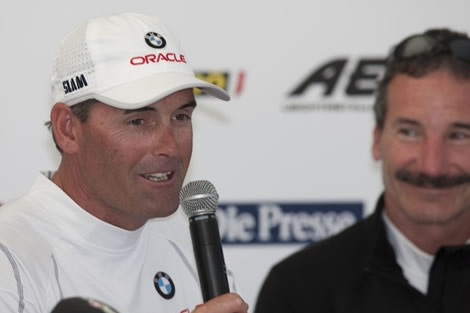
Design and one boat campaigns
Relaxation of the designer rules is likely to be beneficial for smaller teams and Coutts believes a one boat campaign could be more competitive than ever before. “I don’t think there will be much difference in the platforms and there probably isn’t going to be much flexibility in the rigs, so I think a one boat team could be viable. I think a lot is going to come down to sailing these boats well.”
A two boat campaign will benefit from the best in-house racing, but Coutts says there is nothing to stop one boat campaigns from joining forces for training purposes.
Key to the success of a campaign for the 34th America’s Cup he believes will be deciding on where teams focus their resources. With such a potentially ground breaking new boat, it is easy to spear off in too many different directions. For example he says that smaller teams might not need to build the maximum number of wings (two per boat) or foils (up to 10).
However Coutts does believe that foil development will be significantly more important than it has been in previous monohull Cups for it seems extremely likely that at speed the foils will be lifting the leeward hull out of the water, partially or completely, to reduce drag. Among the large trimarans competing in the Route du Rhum the difference between having lifting foils and not having them is said to translate to around 4 knots of boat speed…
“The temptation will be there but I think in reality it will be about using the resources well and using your time well. Time will be the biggest factor.”
Managing the wings
One of the biggest hooplas regarding the move to solid wingsail catamarans has been how they will be managed not only in the 5-33 knot wind range they are supposed to be race in, but particularly what happens when they are brought into port – how the boats are moored and how the wings are taken out in strong winds. This is another issue Iain Murray is in the process of dealing with.
“I really don’t see it as a major issue,” says Coutts. “Stars & Stripessat for two or three years at a mooring. A trimaran you had to moor off the bow, but a catamaran you can moor it underneath the mast ball. I don’t want to make it sound trivial, but I think it will be easier than what people think.”
Stars & Stripes was also occasionally laid over on her side when taken out of the water. “That could be an option. I don’t know. There are various ways you could do it. You could lower it like we did last time.”
But if it is blowing 25 knots? “You just leave it up and it sits there and feathers. With the big wing we had a night where it was 30+ and it was shifty as anything too because it was behind those containers and it was just all over the place, but once again that was moored off the bow so it was a bit more complicated.”
So it sounds like AC World Series venues will need both dock space and a mooring facility for each boat.
It has been suggested from several quarters that if the AC72 were a softsail rig catamaran it might have neatly avoided the docking issues with only a marginal decrease in performance. Coutts says they considered this, but there were two compelling reasons for choosing the wing: “We thought about the manoeuvrability advantages of a wing and also the look of it: We definitely want something that people look at it and say ‘that is the America’s Cup multihull’ and there is no doubt about that.” Coutts maintains it was important to differentiate between the offshore type multihulls sailed in France, many of which are substantially bigger than the AC72s.
Part 2 of this article will be published tomorrow

